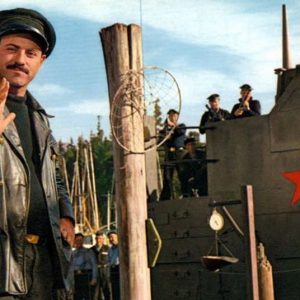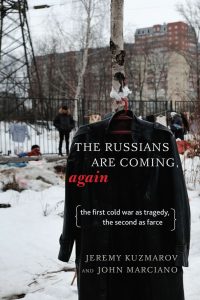The Russians Are Coming, Again: The First Cold War as Tragedy, the Second as Farce
240 pp, $19 pbk, ISBN 978-1-58367-694-3
By Jeremy Kuzmarov and John Marciano
Reviewed by Harry Targ for Socialism and Democracy, vol. 33 (2019), no. 2
The primary purpose of this book is to challenge the popular view that Russia, led by Vladimir Putin, represents a challenge to U.S. democracy much as the former Soviet Union was alleged to have been during the Cold War. The authors, taking The New York Times as their prime source, argue that what is called Russiagate, a story about the nefarious use of computer hacking, spying, and bribing and threatening to expose public figures, including President Trump, is being promoted day-after-day as the root cause of the outcome of the 2016 election. In addition, they suggest that those who vigorously embrace the Russiagate explanation of the 2016 election are claiming that Russia’s interference might be part of a longer-term Russian threat to American democracy. This is so because alleged hackers spread misinformation about candidates and issues, thus distorting dialogue and debate.
The authors review the charges of subversion of the elections that have been “proven”, or so The New York Times claims. The “proof” includes statements released by spokespersons from the FBI, the CIA and other national security agencies that Russian operatives, agencies, and private institutions have hacked social media with “fake news” about candidates running for office (especially, Hillary Clinton). Advocates of this view presume that such misinformation influenced the voter choices of the American electorate. These are the same institutions that figured so prominently in presenting distorted views of a Soviet “threat” during the Cold War that justified the arms race and massive U.S. military expenditures.
To illustrate the seriousness of the charges of the impact of Russia’s interference in the election they quote Thomas Friedman who claimed that the Russian hacking of the election was “…a 9/11 scale event. …that goes to the very core of our democracy.” Along with similar opinion pieces by Charles Blow, Timothy Snyder, and other columnists, news stories, Kuzmarov and Marciano say, have been replete with similar claims. The New York Times narrative concludes that the hacking and interference in the U.S. election is designed to promote victories of candidates for public office who would be sympathetic, and subservient to Russia. The long-range goal of Russia, their stories suggest, is to promote Russian expansionism and its restoration to great power status.
After developing their critique of the Russiagate narrative, Kuzmarov and Marciano, make the case that United States foreign policy since 1917 has been motivated by the desire to crush the Russian Revolution and limit the influence and power of the Soviet Union in world affairs. The Russiagate narrative, they suggest, is primarily a continuation of the story each U.S. administration told the American people about a “Soviet threat” to justify the escalation of the arms race and military spending. They argue that proponents of the Russiagate scenario promote the idea of a new “Russian threat.”
In fact, Kuzmarov and Marciano say, Russia’s foreign policy in the Middle East, Ukraine, and Eastern Europe today reflects its perception of a threat from the United States and the NATO countries. For example, President George Herbert Walker Bush promised Mikhail Gorbachev, that NATO would not establish new military installations in Eastern Europe. With new NATO forward bases in Poland and the United States’ support of a coup in Ukraine, the Russians see the United States as having aggressive intent. From Russia’s vantage point United States threats to Soviet/Russian security have been a feature of East/West relations from the Russian Revolution, through the Cold War, to hostile relations with the United States in the twenty-first century.
All too briefly, Kuzmarov and Marciano review the history of the root causes of the United States’ Cold War policy, the lies perpetrated about the Soviet threat, and the enormous damage Cold War policies did to the American people and the victims of war around the world. For those who have not lived through the Cold War and students who are not taught about alternative narratives to “American exceptionalism” this brief volume is very useful. It draws upon the best of historical revisionist scholarship, including the works of William Appleman Williams, Joyce and Gabriel Kolko, Gar Alperowitz, and Ellen Schrecker. It has chapters on the onset of the Cold War and its causes; the attack by Cold War advocates on democracy; Truman, McCarthy, and anti-communism; and the war against the Global South. In sum, the story begins with the substantial U.S. military intervention during the Russian civil war after the Bolshevik victory and continues to Russiagate today.
The authors effectively develop their two main themes. First, they challenge the argument that Russia, led by Vladimir Putin, represents a threat to U.S. democracy much as the former Soviet Union was alleged to have done during the Cold War. They argue that the Russiagate narrative is fraudulent. Second, they briefly revisit the history of United States/Soviet/Russian relations to argue that the one-hundred-year conflict between the two sides was largely caused by United States’ imperial policies and that proponents of the Russiagate thesis seek to rekindle a new Cold War with Russia.
—Harry Targ
Purdue University, West Lafayette, IN


Comments are closed.